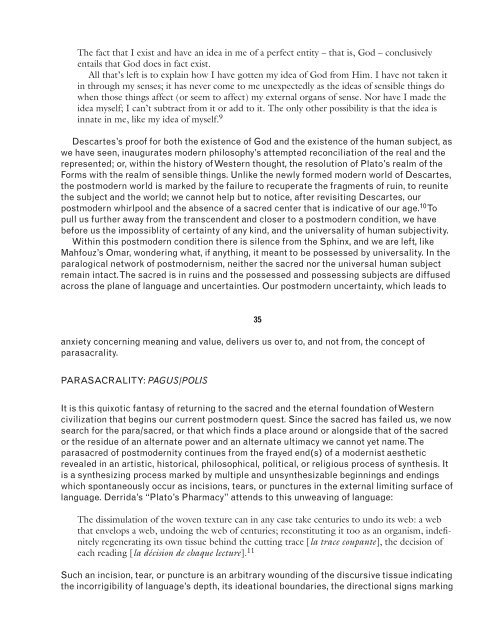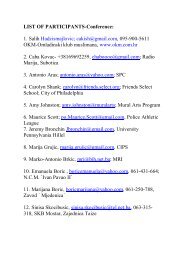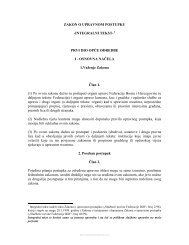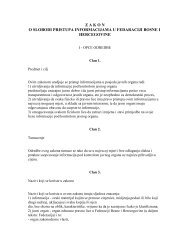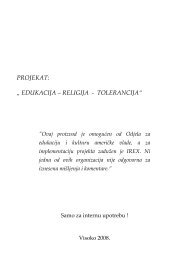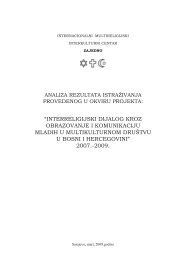The fact that I exist <strong>and</strong> have an idea in me of a perfect entity – that is, God – conclusivelyentails that God does in fact exist.All that’s left is to explain how I have gotten my idea of God from Him. I have not taken itin through my senses; it has never come to me unexpectedly as the ideas of sensible things dowhen those things affect (or seem to affect) my external organs of sense. Nor have I made theidea myself; I can’t subtract from it or add to it. The only other possibility is that the idea isinnate in me, like my idea of myself. 9Descartes’s proof for both the existence of God <strong>and</strong> the existence of the human subject, aswe have seen, inaugurates modern philosophy’s attempted reconciliation of the real <strong>and</strong> therepresented; or, within the history of Western thought, the resolution of Plato’s realm of theForms with the realm of sensible things. Unlike the newly formed modern world of Descartes,the postmodern world is marked by the failure to recuperate the fragments of ruin, to reunitethe subject <strong>and</strong> the world; we cannot help but to notice, after revisiting Descartes, ourpostmodern whirlpool <strong>and</strong> the absence of a sacred center that is indicative of our age. 10 Topull us further away from the transcendent <strong>and</strong> closer to a postmodern condition, we havebefore us the impossiblity of certainty of any kind, <strong>and</strong> the universality of human subjectivity.Within this postmodern condition there is silence from the Sphinx, <strong>and</strong> we are left, likeMahfouz’s Omar, wondering what, if anything, it meant to be possessed by universality. In theparalogical network of postmodernism, neither the sacred nor the universal human subjectremain intact. The sacred is in ruins <strong>and</strong> the possessed <strong>and</strong> possessing subjects are diffusedacross the plane of language <strong>and</strong> uncertainties. Our postmodern uncertainty, which leads toanxiety concerning meaning <strong>and</strong> value, delivers us over to, <strong>and</strong> not from, the concept ofparasacrality.35<strong>PARA</strong>SACRALITY: PAGUS/POLISIt is this quixotic fantasy of returning to the sacred <strong>and</strong> the eternal foundation of Westerncivilization that begins our current postmodern quest. Since the sacred has failed us, we nowsearch for the para/sacred, or that which finds a place around or alongside that of the sacredor the residue of an alternate power <strong>and</strong> an alternate ultimacy we cannot yet name. Theparasacred of postmodernity continues from the frayed end(s) of a modernist aestheticrevealed in an artistic, historical, philosophical, political, or religious process of synthesis. Itis a synthesizing process marked by multiple <strong>and</strong> unsynthesizable beginnings <strong>and</strong> endingswhich spontaneously occur as incisions, tears, or punctures in the external limiting surface oflanguage. Derrida’s “Plato’s Pharmacy” attends to this unweaving of language:The dissimulation of the woven texture can in any case take centuries to undo its web: a webthat envelops a web, undoing the web of centuries; reconstituting it too as an organism, indefinitelyregenerating its own tissue behind the cutting trace [la trace coupante], the decision ofeach reading [la décision de chaque lecture]. 11Such an incision, tear, or puncture is an arbitrary wounding of the discursive tissue indicatingthe incorrigibility of language’s depth, its ideational boundaries, the directional signs marking
the proper path to the sacred, as well as the way of erring. The incision, tear or puncturebegins with Mahfouz’s question: Why do you live? The parasacred interrupts the structuralintegrity of authentic existence (individual <strong>and</strong> social) by first drawing attention to theguiding assumptions which traditionally have led inquiry in the direction of the sacred.In the West, the cultural expression of the human mode of being requires anincontrovertible definition (scientific or religious) of human subjectivity <strong>and</strong>, by implication, adefinition of Otherness or of some other human against which to measure “humanness”.Jacques Derrida, in “Plato’s Pharmacy,” 12 explains this doubleness contained withindefinition by drawing together the ambiguities of the word pharmakon, which in ancient Greekmeans both cure <strong>and</strong> poison. The doubleness of the pharmakon, its status as both cure <strong>and</strong>poison, reflects the organizational logic of early Athenian democracy, which needed thenegative instantiation of the city to form an ideal city:The city’s body proper thus reconstitutes its unity, closes around the security of its inner courts,gives back to itself the word that links it with itself within the confines of the agora, by violentlyexcluding from its territory the representative of an external threat or aggression [en excluantviolemment de son territoire le représentant de la menance ou de l’agression extérieure]. Thatrepresentative represents the otherness of the evil [l’altérité du mal] that comes to affect orinfect the inside by unpredictably breaking into it. Yet the representative of the outside is nonethe less constituted, regularly granted its place by the community, chosen, kept, fed, etc., in thevery heart of the inside. These parasites were as a matter of course domesticated by the livingorganism that housed them at its expense. The Athenians regularly maintained a number of36degraded <strong>and</strong> useless beings at the public expense; <strong>and</strong> when any calamity, such as plague,drought, or famine, befell the city, they sacrificed two of these outcasts as scapegoats [commeboucs émissaires]. 13For the ancient Athenians, what was not a part of the city proper (the polis) was a form ofcontaminate (the pagus). The pagus, or the pagan within the city body, continually threatenedto undo what Athenian citizens had assembled. And yet, as Derrida indicates, the polisneeded the pagus; the citizens needed the pagan to give definition to the sacred throughsacrifice, or expression <strong>and</strong> meaning to the conceptual structures which ordered theircommunity. Just as the pharmakon is both cure <strong>and</strong> poison <strong>and</strong> hagios is both pure <strong>and</strong>polluted, the sacred (le sacré) is simultaneously the holy <strong>and</strong> the accursed. This doublenesscomes to expression in the modern world by way of historical reflection <strong>and</strong> re-enactment.Just as the ancient world constructed an Otherness to define its sacred, the modern worldhas constructed its Other. The city proper [le corps propre de la cité] can be manufacturedalong with an Other, a pagan force, the para/sacred, to reconstitute its continuity with theancient past <strong>and</strong> the sacred secret it holds.NEGATING THE OTHERThe notion of the city set beside itself is best illustrated by the “White City” of theColumbian Exposition of 1893. The World Parliament of <strong>Religion</strong>s, convened in 1893 in
- Page 2: PARA/INQUIRY“For those of us who
- Page 5 and 6: First published 2000by Routledge11
- Page 8 and 9: CONTENTSList of figures ixAcknowled
- Page 10: FIGURES3.1 Questioner of the Sphinx
- Page 14: Posting
- Page 17 and 18: meaning that founds philosophical i
- Page 20: CHAPTER 1Paralogies
- Page 23 and 24: Lyotard’s enjeu, Deleuze and Guat
- Page 25 and 26: In his book Pararealities: The Natu
- Page 27 and 28: acquittal. The horror of the text i
- Page 29 and 30: writer therefore work without rules
- Page 32: CHAPTER 2Parastructures of the sacr
- Page 35 and 36: In this critical space opened by Ni
- Page 37 and 38: Joyce’s Finnegans Wake the exempl
- Page 39 and 40: Deservedly confin’d into this roc
- Page 41 and 42: story of the sacred? Is there but o
- Page 44 and 45: The aspects of things that are most
- Page 46 and 47: AUTHENTICITYThe Sphinx has symboliz
- Page 50 and 51: connection with the Columbian Expos
- Page 52 and 53: through the sacred, so does the com
- Page 54 and 55: appropriation of his thought and of
- Page 56 and 57: use or civil meaning of the word (t
- Page 58 and 59: does not mean that one is sidestepp
- Page 60: of the twentieth century. As Lyotar
- Page 64 and 65: The sacred of the archaic world was
- Page 66 and 67: possibility for an expression of ex
- Page 68 and 69: the actual frame of the panels, the
- Page 70 and 71: space of the painting, and, second,
- Page 72 and 73: much a part of scholarship today. A
- Page 74 and 75: not merely interesting footnotes to
- Page 76 and 77: many to see Eliade as a mystic who
- Page 78 and 79: phenomenology. Eliade’s arrival i
- Page 80 and 81: of the sacred as a child in Romania
- Page 82 and 83: discursive structure to relinquish
- Page 84 and 85: autonomy of the work of art. But ha
- Page 86: CHAPTER 5Para Shoah
- Page 89 and 90: Faurisson reveals that the Shoah is
- Page 91 and 92: MEMORIES OF FORGETTINGCertainty is
- Page 93 and 94: political. Each of these ground(ing
- Page 95 and 96: totalizing discourses or a determin
- Page 97 and 98: Kantian wound often move toward a q
- Page 99 and 100:
Secret fauna and flora which the re
- Page 102:
CHAPTER 6Parasacred ground(ing)s
- Page 105 and 106:
often exist outside (the pagus) the
- Page 107 and 108:
graveyard. The sacred disfigures,be
- Page 109 and 110:
death, which is another repetition
- Page 111 and 112:
able to choose from a range of poss
- Page 113 and 114:
eligious. Mary’s presence as a mi
- Page 115 and 116:
As one walks through a cemetery, ti
- Page 117 and 118:
104Figure 6.15b Clinging to the Cro
- Page 120 and 121:
To think not is to linger with a ne
- Page 122 and 123:
PARASACRED IMAGESNor does one need
- Page 124 and 125:
irreverent piety in so far as eachr
- Page 126:
CHAPTER 8EpilogueParaultimacy
- Page 129 and 130:
The steps, the corridor, to the plo
- Page 131 and 132:
GLOSSARYI should say that in so far
- Page 133 and 134:
The early writings of the French ph
- Page 135 and 136:
NOTESPOSTING1 Michel Montaigne, Apo
- Page 137 and 138:
metaphysical notion of effectivespa
- Page 139 and 140:
and probably goes back to helios.Ea
- Page 141 and 142:
“compensate” the rigidity of th
- Page 143 and 144:
GLOSSARY1 Peter A. Angeles writes(H
- Page 145 and 146:
Stanford: Stanford University Press
- Page 147 and 148:
Riverside Shakespeare edn, Boston:H
- Page 149 and 150:
Carroll, Lewis 23cemeteries 93, 101
- Page 151 and 152:
painting 58; laughter as epiphany 5
- Page 153 and 154:
“paraexperience” 83, 86; the po
- Page 155 and 156:
postmodernism: authenticity 33;ceme
- Page 157 and 158:
Thousand Plateaus, A (Gilles Deleuz


